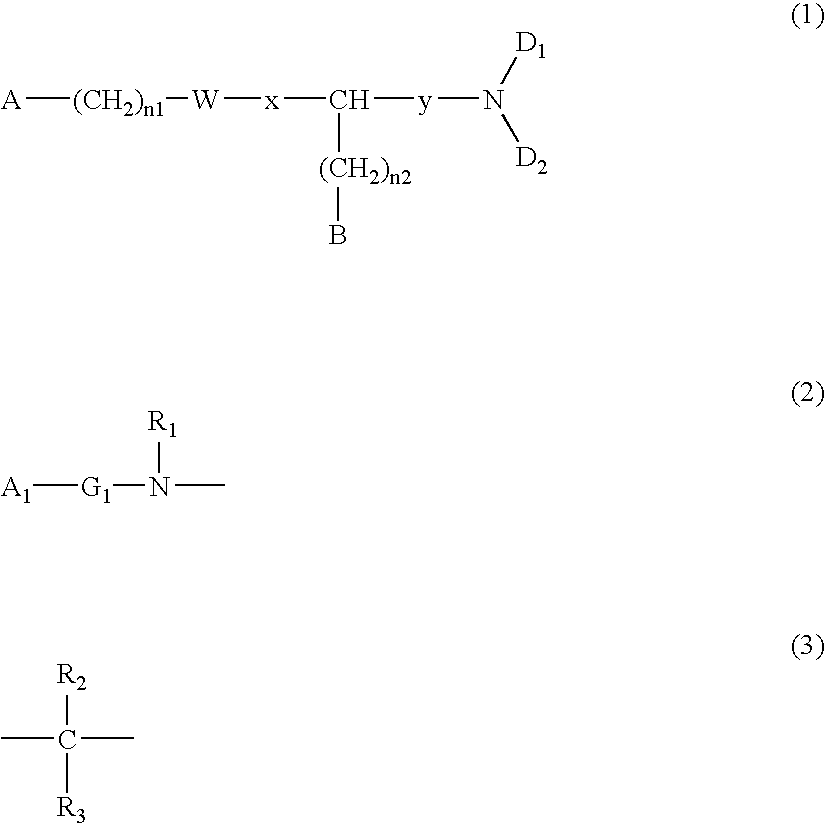Novel Nitrogenous Compound and use thereof
a nitrogenous compound and nitrogenous compound technology, applied in the field of new nitrogenous compound, can solve the problems of increasing the probability of causing emergence and screening of resistant strains, reducing the therapeutic effect of those drugs, and being considered to be extremely difficult, and achieve excellent anti-retrovirus effect, novel chemical structure, and excellent cxcr4 antagonism to sdf-1.alpha.
- Summary
- Abstract
- Description
- Claims
- Application Information
AI Technical Summary
Benefits of technology
Problems solved by technology
Method used
Image
Examples
example 2
Production Method Example 2
[0098] FIG. 2 shows a reaction scheme of Production Method Example 2.
[0099] Step 2-1
[0100] A commercially available or known compound (XIII) (P.sub.2, Z.sub.2, and y are the same as described above; n.sub.3 represents an integer of 0 to 3; and R.sub.21 represents an alkyl group, an benzyl group, etc.) and an amine compound HND.sub.1D.sub.2 (the same as described above) may be reacted in an organic solvent, while adding a known condensation agent (e.g., carbodiimide or chloroformate) and, if necessary, a catalyst (HOBt, DMAP or triethylamine) at -20.degree. C. to 120.degree. C., thereby obtaining a compound (XIV).
[0101] Step 2-2
[0102] A compound (XV) may be obtained by removing the protecting group P.sub.2 from the compound (XIV). For example, when P.sub.2 is a Boc group, a strong acid such as a hydrochloric acid, a trifluoroacetic acid, etc. or a weak acid such as an acetic acid, etc. may be caused to act in any solvent to complete the reaction.
[0103] Step...
production example 1
[0280] Synthesis of N-[(S)-1-(1-naphthyl)ethyl]-5-(2-methylbenzyl)amino-2--(S)-[4-[N-(imidazol-2-ylmethyl)aminomethyl]benzoyl]aminopentanoylamide [Compound No. 1]
example 1-1
[0281] Synthesis of 4-(N-Boc-N-(imidazol-2-ylmethyl)aminomethyl)benzoic acid (Compound VI-1)
[0282] Commercially available methyl bromomethylbenzoate (10.01 g) was dissolved in DMF (100 ml), and the solution was added with potassium phthalimide (9.70 g) and stirred at room temperature for 1.5 hours. After completion of reaction, the solution was concentrated, and water was added to the concentrate. Then, extraction was performed with chloroform. The resultant solution was washed with brine and dried with anhydrous sodium sulfate, and the solvent was distilled off, to thereby obtain a white solid (12.91 g). Subsequently, a portion (7.56 g) of the obtained solid was dissolved in methanol (100 ml), and the solution was added with hydrazine monohydrate (6.25 ml) and stirred at 60.degree. C. for 1.5 hours. After completion of reaction, the precipitated solid was separated by filtration, and the solvent was distilled off. Water was added to the residue, and extraction was performed with ch...
PUM
| Property | Measurement | Unit |
|---|---|---|
| Length | aaaaa | aaaaa |
| Length | aaaaa | aaaaa |
| Length | aaaaa | aaaaa |
Abstract
Description
Claims
Application Information
 Login to View More
Login to View More - R&D
- Intellectual Property
- Life Sciences
- Materials
- Tech Scout
- Unparalleled Data Quality
- Higher Quality Content
- 60% Fewer Hallucinations
Browse by: Latest US Patents, China's latest patents, Technical Efficacy Thesaurus, Application Domain, Technology Topic, Popular Technical Reports.
© 2025 PatSnap. All rights reserved.Legal|Privacy policy|Modern Slavery Act Transparency Statement|Sitemap|About US| Contact US: help@patsnap.com



